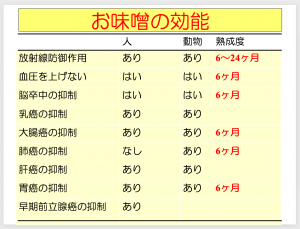Effective for aging for half a year to two years
Atsumitsu Watanabe, professor emeritus at Hiroshima University, began researching miso at the dawn of the Heisei era.
since30Over the years, he and his colleagues conducted steady experiments, proving that the salt contained in miso does not raise blood pressure.
Mr. Watanabe, who is still immersed in his research life at Hiroshima University, has summarized the story that he gave in the joint lecture on the theme of "efficacy of miso".
Loved for XNUMX years
According to Mr. Watanabe, miso, which has a deep connection with the Japanese people, has been eaten for XNUMX years.
Miso, which is excellent in storage and portability, was also favored by military commanders during the Sengoku period.
“The soldiers fought with miso balls hanging from their waists. When they were hungry, they could pour water into the jinkasa and dissolve the miso balls to make miso soup. It's
He also told an episode about how miso was applied to the walls of the castle, and the people who were caged in the castle ate the wall to stave off hunger.
The effects of miso have been well known since ancient times. It makes the body glow, stops pain, prevents pimples, stimulates appetite, lowers fever, warms the chills, soothes strong-tempered people, revitalizes weak people, slows down impatient people, etc. It's written to work on everything."
“I am convinced that miso has been around for XNUMX years because it was so good,” says Mr. Watanabe.
On the other hand, miso soup, which has been so loved by Japanese people, was called omiotsuke until the XNUMXth edition of Kojien. I lamented what had happened.
For lung, stomach, and colon cancer
Smoking is a major cause of lung cancer.
"The word 'cancer' is written as three mouth diseases: eating too much, drinking too much, and smoking too much."
In fact, an American survey found that when the number of male smokers increased during World War I,20Lung cancer is increasing year by year.
When women started smoking post-WWII women's ribs,20Lung cancer increased year after year.
However, studies on Japanese people have shown that the more miso soup is consumed, the lower the mortality rate from lung cancer in both smokers and non-smokers.
Watanabe et al. conducted an experiment in which miso was given to mice that had developed lung tumors (adenocarcinoma) due to carcinogenic substances. It was found that rats fed with miso were more effective in suppressing cancer.
“Among lung cancers, squamous cell carcinoma is a cancer caused by smoking, and adenocarcinoma is a cancer caused by chemical substances.
Aged miso reduces adenocarcinoma.Maturity is extremely important."
In fact, the fact that matured miso is effective is common to many other cancers.
In his lecture, Mr. Watanabe mentioned stomach cancer, colon cancer, liver cancer, and prostate cancer.
The effect of aging for 10 years is zero
Aged miso is also effective in radiation protection.
Dr. Tatsuichiro Akizuki, who was exposed to the atomic bombing near the hypocenter in Nagasaki, continued to eat miso soup and brown rice balls with his staff and patients, and continued his medical treatment.
Even in Hiroshima, where the atomic bomb was dropped, a person involved in a major miso maker at the time went to the city to look for his family who had been exposed to the atomic bombing. .
After learning about these experiences, Mr. Watanabe and his colleagues embarked on full-fledged miso research.
We focused on the small intestine, where cells divide so rapidly that it is said to be reborn in three and a half days.
The stronger the radiation exposure, the less new cells the small intestine can produce.
Mice that had eaten miso-containing food were exposed to high-level radiation for a week, and when dissected three and a half days later, they continued to produce new cells even after radiation exposure.
On the other hand, the rats fed the normal diet and the mice fed the diet containing the same concentration of salt as the miso were unable to generate new cells as much as the mice fed the miso diet.
Moreover, the miso-containing food lived longer after irradiation.
Experiments were also conducted using miso aged for different periods.10The effect was zero when it matured.
Regardless of the type of miso, miso that has been aged for six months to two years is said to be the most effective in suppressing cancer.
As a way to use the radiation protection effect, ``If you eat aged miso for half a year to two years from about a week before the CT scan, and continue to eat miso even after the examination (risk of developing cancer) It is said that radiation damage will increase),” said Mr. Watanabe.
* The efficacy of miso shown in the lecture.Epidemiologically, the efficacy of miso against lung cancer is not recognized, so the efficacy is listed as "none", but it has been found to be effective in animal experiments, and Watanabe believes that it can also prevent lung cancer ( Watanabe-san's data).
Miso from the world's superfoods to Mr. Atsumitsu Watanabe②